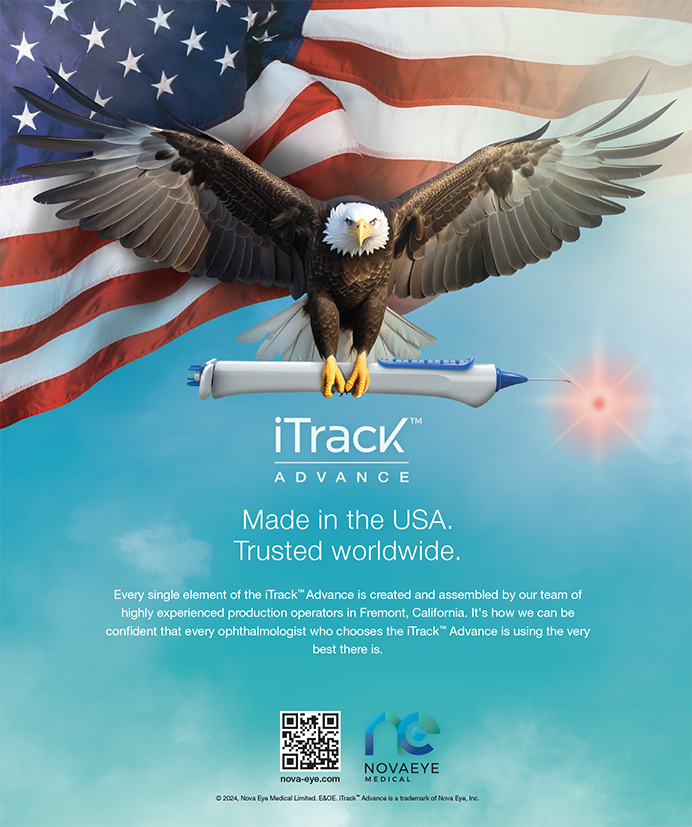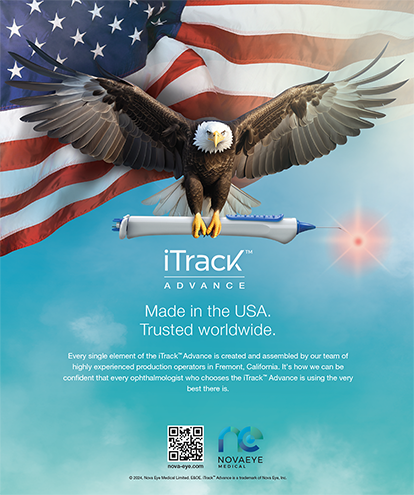A LASIK-associated corneal epithelial defect is a potentially significant complication that may result in suboptimal visual results. This article discusses the etiology, management, and prevention of this clinical challenge.
CLASSIFICATION AND CAUSES OF DEFECTS
Epithelial defects associated with LASIK can be classified as central or peripheral, small or large, and traumatic or toxic. Large central defects are most likely to occur bilaterally and cause complications, whereas small peripheral defects are less likely to affect visual recovery and outcomes. Most defects are thought to be related to trauma caused as the microkeratome slides across the epithelial surface. The excessive use of a topical anesthetic prior to the keratome’s pass can loosen the epithelium.
The vast majority of eyes that experience epithelial defects during LASIK presumably had unrecognized epithelial basement membrane dystrophy (EBMD) preoperatively. Although as much as 5% of the population is thought to have EBMD, few people have signs of the condition on preoperative examination or have a history of recurrent erosion, and fewer still develop epithelial defects during LASIK. Eyes with more profound and extensive areas of defective hemidesmosomes and anchoring fibrils are vulnerable to the minor trauma of a microkeratome’s sliding across the epithelium. A careful preoperative examination with tangential and retroillumination as well as fluorescein staining of the tear film is important to identify eyes with preoperative signs of EBMD. Patients with preoperative signs of EBMD or a history of recurrent corneal erosion should be pretreated with anterior stromal puncture before LASIK or have surface ablation. When we perform surface ablation on the eyes of patients with EBMD and a history of recurrent corneal erosion, we also puncture the anterior stroma in the cornea outside the area of ablation. We find that this strategy reduces the postoperative risk of recurrent erosion.
The incidence of epithelial defects during LASIK with a Hansatome microkeratome (Bausch + Lomb, Rochester, NY) has been reported to be as high as 22% in one study1 and 1.3% for severe epithelial defects2 (> 20% of the flap’s surface). Different microkeratomes have different rates of associated epithelial defects. Conversion from the stan- dard Hansatome to the Hansatome’s zero-compression head led to a 10-fold reduction in the incidence of epithelial defects in one study.1
RISK FACTORS AND IMPLICATIONS
Other than EBMD, risk factors reported for epithelial defects during LASIK are an age of more than 40 years, hyperopia, greater corneal thickness, and surface drying during the keratome’s pass.3-6 EBMD seems to be the predominant underlying factor, however. Lubrication of the ocular surface with carboxymethylcellulose 0.5% during the keratome’s pass has been reported to significantly reduce the incidence of epithelial defects.7
The presence of an epithelial defect on a freshly created LASIK flap, especially if it involves the visual axis, will delay visual recovery. An epithelial defect can increase the patient’s risk of developing diffuse lamellar keratitis (DLK) 24-fold,8 with subsequent flap striae and epithelial ingrowth. In eyes with a microkeratome-associated epithelial defect that involves 20% or more of the flap, the incidence of DLK is reported to be 91%.1 Additionally, 72% of eyes had epithelial ingrowth, with half of those showing flap melting.9 Eyes that develop DLK and epithelial ingrowth can experience poor UCVA and a temporary loss of BCVA, and they can take as much as a year to recover. Surgeons should treat severe DLK by lifting the flap and performing careful irrigation. They should manage visually significant flap striae by lifting the flap and then smooth- ing it to reduce the subsequent irregular astigmatism. Significant or symptomatic epithelial ingrowth is treated by lifting the flap and removing the invading epithelium, although recurrence is a frequent problem. It is likely that the poor epithelial adhesion associated with EBMD predis poses the see yes tore current epithelial in growth.
TREATMENT AND PREVENTION
In our experience, the use of a bandage contact lens such as the PureVision (base curve 8.6; Bausch + Lomb) applied at the end of the procedure and left in place for 3 to 5 days dramatically reduces the incidence of complications in eyes with epithelial defects. In eyes with large central defects, we have found that anterior stromal puncture with a 30-gauge needle over the defect and the surrounding area of loose epithelium—in conjunction with a bandage contact lens—markedly reduces complications and hastens visual recovery.
When a large central epithelial defect occurs in one eye, the risk that an epithelial defect will develop in the second eye is very high.2 This fact raises the question of whether a flap should be created with a microkeratome in the fellow eye or whether surface ablation would be better. Using the anterior stromal puncture technique described previously, we have not found it necessary to convert to surface ablation in the fellow eye.
LASER FLAPS
For the past few years, we have been using a femtosecond laser exclusively to create LASIK flaps, and this transition has markedly reduced the incidence of epithelial defects in our LASIK practice. Use of the IntraLase FS laser (AbbottMedicalOpticsInc.,SantaAna,CA)eliminates the shearing action of the mechanical microkeratome. Although a femtosecond laser will not itself tear the epithelium,eyeswithsevereEBMDmayhavelargecentral areas of loose epithelium. If the surgeon is not careful to avoid traumatizing these areas when lifting and repositioning the flap, he or she may create an epithelial tear, which will slow the patient’s postoperative recovery. We place a bandage contact lens on all eyes with severe EBMD and place collagen plugs in the lower and upper cannaliculi. In eyes with large central areas of loose epithelium, we will also perform anterior stromal puncture with a 30-gauge needle before applying the contact lens. We have never had an eye with an Intralase-created flap develop DLK, striae, or epithelial ingrowth using this strategy.
CONCLUSION
The use of a femtosecond laser eliminates the shearing stress that the microkeratome places on the vulnerable epithelium of eyes with EBMD. LASIK surgeons can decrease the risk of EBMD-related complications by using a low-compression microkeratome and more viscous lubricants during the device’s pass, switching to a femtosecond laser for the creation of the flap, and/or using bandage contact lenses and anterior stromal puncture to prevent complications.
A video of Dr. Speaker’s post-LASIK anterior stromal puncture technique is available at http://eyetube.net/?v=delum.
Mark Speaker, MD, PhD, is with Laser and Corneal Surgery Associates, PC, in New York, New York, and is the New York regional medical director of TLC, The Laser Center. He acknowledged no financial interest in the products or companies mentioned herein. Dr. Speaker may be reached at (212) 832-2020; mspeakermd@gmail.com.
Theresa Nguyen, DO, is in practice at Laser and Corneal Surgery Associates, PC, in New York, New York. She acknowledged no financial interest in the products or companies mentioned herein. Dr. Nguyen may be reached at (212) 832-2020; teekimo@hotmail.com.
- KohnenT,TerziE,MirshahiA,BuhrenJ.Intraindividualcomparisonofepithelialdefectsduringlaserinsituker- atomileusis using standard and zero-compression Hansatome microkeratome heads.J Cataract Refract Surg. 2004;30:123-126.
- MirshahiA,BuhrenJ,KohnenT.Clinicalcourseofseverecentralepithelialdefectsinlaserinsitukeratomileusis.J Cataract Refract Surg.2004;30:1636-1641.
- DastgheibKA,ClinchTE,MancheEE,etal.Sloughing of cornealepi the lium and wound healing complications associated with laser in situ keratomileusis in patients with epithelial basement membranedystrophy.AmJ Ophthalmol. 2000;30:297-303.
- Randelman JB,Lynn MJ,Banning CS,Stulting RD.Risk factors for epithelial defect formation during laser in situ keratomileusis.J Cataract Refract Surg.2007;33:1738-1743.
- TekwaniNH,HuangD.Riskfactorsforintraoperativeepithelialdefectinlaserinsitukeratomileusis.AmJ Ophthalmol. 2002;134:311-316.
- Ti SE,Tan DT.Recurrent corneal erosion after laser in situ keratomileusis.Cornea.2001;20:156-158.
- AheeJA,KaufmanSC,SamuelMA,etal.JCataractRefractSurg.2002;28:1651-1654.
- Shah MN,Misra M,Wilhelmus KR,Koch DD.Diffuse lamellar keratitis associated with epithelial defects after laser insitukeratomileusis.JCataractRefractSurg.2000;26:1312-131
- Perez-Santonja JJ,Galal A,Cardona C,et al.Severe corneal epithelial sloughing during laser in situ keratomileusis as a presenting sign for silent epithelial basement membrane dystrophy.J Cataract Refract Surg.2005;31:1932-1937.


